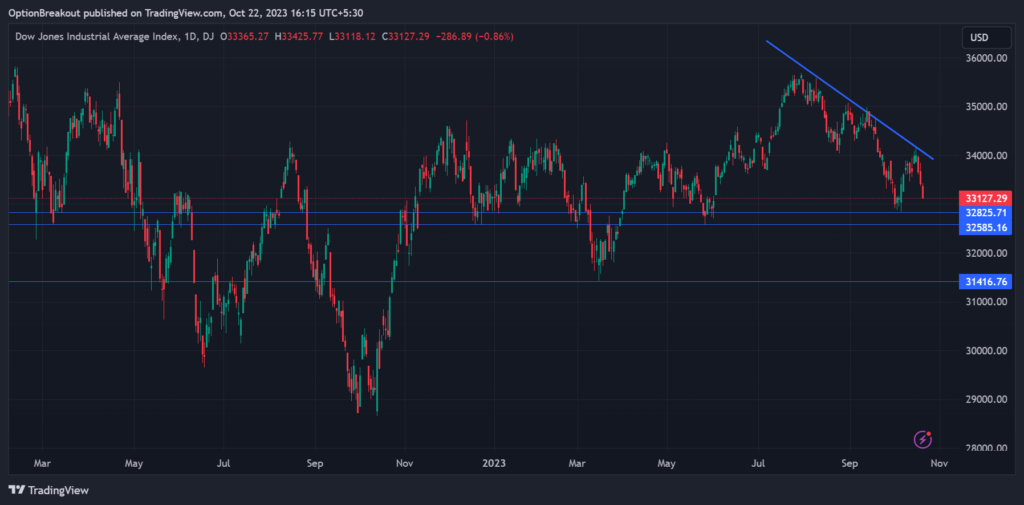The stock market crash this week will depend on many factors. From geopolitical tensions to the Fed’s move to the technical setup of the market, it will trigger the trend in the short term. The war between Israel and Hamas changed the short-term outlook of the markets from bullish to bearish.
Due to the conflict in the Middle East, Brent crude prices spiked above $90 last week. Also, U.S. 10-year bond and dollar index are at alerming levels now. So any further escalation in that region will increase volatility worldwide that can trigger a stock market crash this week.
Will the stock market crash this week?
The US markets fell for the last two months, which is a sign of weakness in the equity market. So the stock market crash will again depend on the three benchmarks indices of the US stock market. The hawkish Fed and relentless moves in 10-year bonds are pushing investors into a risky zone.
The S&P 500, Dow Jones, and Nasdaq Composite declined by 2.39%, 1.61%, and 3.16%, respectively, last week from their previous week’s closings. So, for the next week, these three indices must bounce; otherwise, we can see a sharp fall below their critical supports.
Key Triggers for the Stock Market Crash
There are a number of things that can send bears to Wall Street and cause a stock market crash. But we must carefully consider those factors and comprehend how they will affect the stock market this week.

Here are the important triggers:
Israel and Hamas Conflict:
For the past nine days, Israel has maintained its ground operation in the Gaza Strip. Considering the circumstances, neither Israel nor Hamas will put an end to the conflict any time soon. Most Muslim nations have already publicly expressed their hatred toward Israel.
Therefore, the situation will worsen unless Israel halts its invasion. The Middle East will then be vulnerable since a third party entering the fight is a possibility.
Crude oil price:
The unrest in the Middle East caused Brent oil prices to rise rapidly above $90. Last week, the WTI crude oil price passed $88 per barrel and the Brent oil price surpassed $93 per barrel. The rising price of oil was a reflection of the continuous turmoil in the Middle East.
Brent will rise beyond $95 per barrel this week as a result of further escalation, and it may even reach the recent high above $97.6 per barrel. The majority of analysts are worried about a stock market crash that will occur at any price above $100 per barrel.
US 10-year bond yield:
The yield on US 10-year bonds has been rising during the past month. The US Fed’s hawkish stance fueled its unrelenting movement. Last week, it increased to a high of 4.999.
A new selloff in the equity markets will start if the bond rate rises above 5%. Therefore, the current position is highly ominous, and investors are concerned about the possibility of the Fed raising interest rates.
US housing market crash:
Despite skyrocketing mortgage rates, the U.S. housing industry is still strong, with home values rising consistently. This resiliency is attributed by experts to a number of important variables, including a scarcity of available homes, delayed building, demographic changes, strict lending criteria, and a lack of foreclosure activity.
Although the housing market may be cooling, this downturn is unlike others and there won’t be a sharp decline in prices. Homebuyers still struggle with affordability, but a full-blown market catastrophe seems unlikely any time soon.
US Dollar Index
The US Dollar Index (Dxy) is hovering above 106. So far in October, it’s been consolidating in the range between 105.5 and 107.3. In the last month, dxy climbed over 2.5%, triggering a selloff in the US stock market.
The surge in the dollar index has shown resilience in the US economy, which can encourage Fed officials to become more hawkish and market-unfriendly. So, a rally above 107 will trigger sharp profit booking in commodities, especially base metals. Also, we can see a meltdown in equities due to the fear of further rate hikes.
The production cuts by OPEC+ countries and the demand in China, however, suggest that crude may not be in the same category. This will offset the dollar index surge. So, the risk in crude oil will remain there despite the rally in the dollar index.
Also read Oil Prices Jumped Over 4% on the Fear of Supply Disruptions
How to Deal With the Stock Market Crash This Week
The inclusion of a third front in the ongoing clash between Israel and Hamas will trigger spikes in oil prices globally. So, this will badly impact the global equity markets this week. Additionally, the dollar index and US 10-year bonds are also lingering around levels that could become alarming in the days to come.
Therefore, this week, traders and investors should proceed with extreme caution. The S&P 500, Nasdaq Composite, and Dow Jones have already finished the week on the downside, down 1.5–3%.
- Dow Jones: The 30 largest significant companies in the U.S.
- Price Action Trading: Unlock the full potential of Profits
Dow Jones Forecast For This Week: 23–27 October
In all periods, from short to medium, the Dow Jones Industrial Average’s chart structure appears to be highly fragile. There is a significant weakness in the higher levels shown in the hourly, daily, and weekly time frames. On the daily chart, the formation of lower lows and lower highs indicates additional weakness for this week. The recent tops around 35700, 35000, and 34150, as well as the corresponding bottoms, support the Dow Jones chart’s bearishness.

Now, on the lower side, 34000 will be a make-or-break on the closing basis. Though the price action suggests the support won’t work at this moment. The price of Dow Jones can go beyond 33000 to make new lows up to 32600. But the area between 32800 and 32600 will act as a very strong support area.
A further 1000-point drop in the Dow Jones in the upcoming sessions is possible if zones 32800–32600 are violated. So, the next most critical support area will be around 31500.
If we look at the DJIA chart’s leading and lagging indicators, they are all displaying a bearish pattern. Moving averages, stochastic, macd, RSI, and ADX are all displaying bearish signs.
From the very short term to the longer term, the Dow Jones price trades significantly below the moving averages. On the daily chart, the 20-day and 50-day MAs are 33554.09 and 34181.87, respectively. According to the technical setup, it indicates that the outlook for the DJIA is very gloomy.
The downward-sloping trend line breakout will take place in the Dow Jones only above 34200 on a closing basis. The 20-day and 50-day MAs, however, will serve as hurdles first. The initial resistance for the DJIA will be at 35,000 after a bearish trend reversal, according to the price pattern.
The Bottom Line
As the new trading week unfolds, market participants are closely monitoring the Dow Jones Industrial Average (DJIA), S&P 500, and Nasdaq Composite. This week’s forecast for the DJIA includes a mix of technical analysis and key trading indicators.
When you consider the prices of bonds, the dollar index, and crude oil in addition to geopolitical tensions, the scenario currently appears to be frightening. Middle Eastern issues are currently in a precarious state. Therefore, any new development that involves other countries will intensify the situation to an excessive level. The global stock market will then crash this week.
Bond yields, the dollar index, oil prices and indications of a reduction in geopolitical tensions will only help boost the US indices and other markets.
Visit Sensitrend home for more exciting articles




